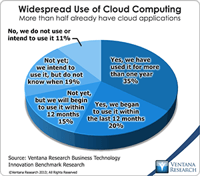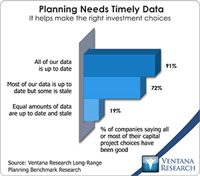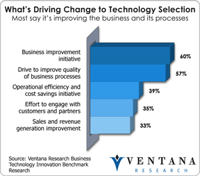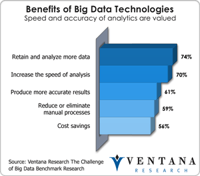There’s a growing realization that the multitenant approach to the cloud isn’t the only option that companies should weigh in deciding between deploying software on-premises and in the cloud. That some people describe the multitenancy approach as “the real cloud” reflects the contentious nature of some technical debates, especially those that occur early in the evolution of a new technology. Multitenancy does have advantages that confer cost savings, and these have been important in the first...
Read More
Topics:
Microsoft,
Mobile,
SaaS,
Sales,
Salesforce.com,
ERP,
HCM,
Human Capital,
Office of Finance,
Planview,
Concur,
Dynamics AX,
Dynamics GP,
Dynamics NAV Dynamics SL,
PSA,
Sage Software,
Unit4,
Analytics,
Business Performance,
Cloud Computing,
Financial Performance,
Workforce Performance,
CFO,
FinancialForce,
HR,
Infor,
Tagetik,
Workday,
Plex
In the realm of technology that matters for business and IT, our firm as part of our responsibility continually assesses the latest technology and how it can impact organizations’ efficiency and effectiveness. Our benchmark research in technology innovation found that 87% of participants indicated the importance of increasing the organization’s value through technology innovation. Every year we take our knowledge from research and technology briefings to focus on our Technology Innovation Awards
Read More
Topics:
Big Data,
Datameer,
Mobile,
Sales,
Sales Performance,
Social Media,
Supply Chain Performance,
Sustainability,
Customer,
ESRI,
Globoforce,
GRC,
HCM,
Kronos,
Kyriba,
Location Analytics,
Marketing,
NetBase,
Office of Finance,
Overall Operational Leadership,
Peoplefluent,
Planview,
SQLstream,
VMWare,
VPI,
IT Analytics & Performance,
IT Performance,
Operational Performance,
Analytics,
Business Analytics,
Business Collaboration,
Business Intelligence,
Business Mobility,
Business Performance,
CIO,
Cloud Computing,
Collaboration,
Customer & Contact Center,
Financial Performance,
Governance, Risk & Compliance (GRC),
Hortonworks,
IBM,
Informatica,
Information Applications,
Information Builders,
Information Management,
Information Technology,
KXEN,
Location Intelligence,
Operational Intelligence,
Oracle,
Workforce Performance,
Contact Center,
Datawatch,
Financial Management,
Information Optimization,
Johnson Controls Panoptix,
Roambi,
Service & Supply Chain,
Upstream Works,
Vertex,
Xactly
Planview recently announced general availability of Planview Enterprise 11. The new release enhances the user experience through a comprehensive redesign of the interface to promote ease of use. The changes are intended to facilitate an integrated approach to long-range planning of capital projects and major corporate initiatives across departments. There’s an important difference between strategic and long-range planning, and this difference is the reason why long-range planning benefits from...
Read More
Topics:
Big Data,
Performance Management,
Planning,
Sales Performance,
Supply Chain Performance,
Office of Finance,
Planview,
Reporting,
FEI,
FERF CEO,
Operational Performance,
Business Performance,
Financial Performance,
CFO,
Financial Performance Management,
FPM
Read More
Topics:
Sales Performance,
SAP,
Social Media,
Supply Chain Performance,
Peoplefluent,
Planview,
Research,
Splunk,
IT Performance,
Operational Performance,
Business Analytics,
Business Collaboration,
Business Intelligence,
Business Performance,
CIO,
Cloud Computing,
Customer & Contact Center,
Financial Performance,
IBM,
Information Applications,
Information Management,
Location Intelligence,
Operational Intelligence,
Workforce Performance,
Ceridian,
CFO,
CMO,
COO,
Datawatch,
Saba,
Technology
I had a refreshing call this morning with a vendor that did not revolve around integration of systems, types of data, and the intricacies of NoSQL approaches. Instead, the discussion was about how its business users analyze an important and complex problem and how the company’s software enables that analysis. The topic of big data never came up, and it was not needed, because the conversation was business-driven and issue-specific.
Read More
Topics:
Big Data,
Datameer,
Predictive Analytics,
Sales Performance,
Supply Chain Performance,
Planview,
SuccessFactors,
Operational Performance,
Analytics,
Business Analytics,
Business Intelligence,
Business Performance,
Customer & Contact Center,
Financial Performance,
IBM,
Information Management,
Operational Intelligence,
Workforce Performance,
PivotLink
In today’s economy, all companies are contending with a dynamic business environment characterized by volatile commodity prices and exchange rates, a shaky global financial system and slow growth in many countries. Many of them rely heavily on desktop spreadsheets to support the data collection and analysis related to their capital-asset planning. However, spreadsheets have inherent limitations that make them the wrong choice.
Read More
Topics:
Big Data,
Planning,
SAP,
Office of Finance,
Planview,
Budgeting,
contingency,
Operational Performance,
Business Performance,
Financial Performance,
IBM,
Oracle,
agile,
capital spending














